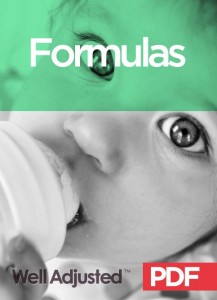 Choosing a formula can be tricky and lots of mums ask for my recommendations and suggestions. New research 1 shows that consumption of soy formula may now be associated with a higher rate of seizures in children. It’s no secret that I have never been a fan of Soy Formula and these new reports confirm why parents should avoid it wherever possible.
Choosing a formula can be tricky and lots of mums ask for my recommendations and suggestions. New research 1 shows that consumption of soy formula may now be associated with a higher rate of seizures in children. It’s no secret that I have never been a fan of Soy Formula and these new reports confirm why parents should avoid it wherever possible.
While soy formulas maybe lactose-free and non-mucus-producing there is a mountain of evidence that stands against this milk being offered to our children. This recent study led by Cara Westmark from the University of Wisconsin-Madison, USA, explained that the investigation was sparked by mouse studies of a drug that, it was hoped, would inhibit seizures by blocking signals that excite nerve cells. Findings from an initial study on mice led the team to investigate the links between soy and seizures in a group of nearly 2,000 infants fed either dairy or soy based formula. The findings showed that children with autism who were fed soy formula had 2.6 times as many febrile seizures as the children fed non-soy formula in the database.
CONCERNS SURROUNDING SOY FORMULA
In chapter 17 of Well Adjusted Babies 2nd Edition, I discuss the many suggested adverse effects of soy formula, here are the top five:
1 – The phytoestrogens present in soy are known to behave like a weakened form of the female hormone oestrogen, possibly affecting the hormonal balance of a growing child.2 Animal studies indicate that soy (both conventional and organic) contain powerful endocrine disrupters that alter growth patterns and cause sterility. Babies fed soy-based formula had 13,000 to 22,000 times more isoflavones in their blood than babies fed milk-based formula. 3
Toxicologists estimate that an infant exclusively fed soy formula receives the oestrogenic equivalent of at least five birth control pills per day.4
Dr Kaayla Daniel, author of The Whole Soy Story5—the most comprehensive book ever written on soy—outlines the health implications and dangers involved when utilising soy formulas. She states:
- Soy impedes the sexual maturation of boys.
- Soy accelerates the sexual maturation of girls.
- In newborns, the hormonal effects of soy may be irreversible.
By contrast, almost no phytoestrogens have been detected in dairy-based infant formula or in human milk, even when the mother consumes soy products.6 Scientists have known for years that isoflavones in soy products can depress thyroid function, causing autoimmune thyroid disease and even cancer of the thyroid.
“The Ministry of Health has found that infants with a history of thyroid dysfunction should avoid soy formulas and soy milks. Additionally, there is potential for isoflavone exposure to cause chronic thyroid damage in all infants fed soy formulas”
Fitzpatrick stated that exposing infants to isoflavones was unnecessary and that the risk of harm could be avoided if manufacturers removed isoflavones from soy formulas. “In the interim” he stated “it is appropriate for medical practitioners to monitor the thyroid status of infants fed soy formulas”7
2 – Two studies by University of Illinois food science and human nutrition professor Sharon Donovan show that the soy isoflavone genistein, in amounts present in commercial soy infant formulas, may inhibit intestinal cell growth in babies.8
3 – Early exposure to soy protein and wheat protein has been associated with increased incidence of diabetes.9
4 – While the carbohydrates found in soy formulas are sucrose and corn syrup— which are readily digested and absorbed, being lactose-free—these formulas are sweetened with glucose syrup or other agents which have been implicated as a major cause of tooth decay.10 The damaging effects of glucose on the developing immune system must also be considered.
5 – Soy formulas often contain potentially high concentrations of aluminium and manganese. In fact, soy has 11 times (1100%) more aluminium than traditional formula.11 Soy is not a healthy formula option and fortunately there are safer and healthier formulas available. If you are struggling with breastfeeding and contemplating formula feeding, first please consider the following information.
 BUT BREASTFEEDING IS REALLY HARD!
BUT BREASTFEEDING IS REALLY HARD!
Breastfeeding isn’t always easy, sometimes choosing to use a formula is the best decision for a family. Some mother-baby duos face significant challenges with breastfeeding, and alternatives are then sought. A study of 239 breastfeeding mothers found that only 46% continued breast- feeding after 22 weeks.12
Of the reasons given for foregoing breastfeeding, 59% were related to the infant’s supposed inability to nurse properly. The good news is if you are struggling with breastfeeding chiropractors are skilled and trained to help.
One research paper discusses how chiropractic can play an important role in helping to resolve difficulties with breastfeeding. In a study of 114 infants diagnosed with feeding problems, chiropractors found that 89% demonstrated neck joint restrictions, 36% showed jaw imbalance, 34% had inadequate sucking reflexes and close to 14% exhibited overt signs of birth trauma13.
All had previously been seen by other practitioners including midwifes, lactation consultants, and paediatricians. After receiving chiropractic care in addition to the support given elsewhere, all children showed improvement with 78% being able to exclusively breastfeed after 2 to 5 treatments within a 2-week time period.
A second study of 25 infants with breastfeeding difficulties found that all babies were unable to open their mouths wide enough to encompass the breast tissue or close their mouths to create adequate suction 14. They were also unable to use their tongues effectively compared to controls. The majority of the babies were found to have an imbalance in the muscles around the neck and jaw along with improper movement of corresponding joints. Chiropractic adjustments and soft tissue therapy resulted in improved nursing for over 80% of the babies.
Chiropractic adjustments work to safely and effectively address dysfunction of the skull, jaw or the cervical spine and help restore natural, efficient suckling patterns for infants.
There are often many factors involved with breastfeeding challenges and I discuss this further in the blog post: Why Is Breastfeeding So Hard Sometimes?
 If breastfeeding is not an option, or if you have breastfed for a period of time and would now like to use a formula, then please review the above blog post and my Formulas chapter which outlines more important information including:
If breastfeeding is not an option, or if you have breastfed for a period of time and would now like to use a formula, then please review the above blog post and my Formulas chapter which outlines more important information including:
-
PICKING FORMULA’S
-
FORMULA BUYING GUIDE
-
FORMULA FEEDING TIPS
-
HEALTHY TIPS FOR BOTTLE FEEDING
-
GOAT’S MILK FORMULA
-
HOMEMADE FORMULAS
. . . . .
Yours in health…
Jennifer Barham-Floreani
Bach. Chiropractic, Bach. App Clinical Science
Registered internationally, no longer practicing as a chiropractor in Australia.
REFERENCES
1) CJ. Westmark. Soy Infant Formula and Seizures in Children with Autism: A Retrospective Study. March 12, 2014DOI: 10.1371/journal.pone.0080488 https://www.plosone.org/article/info
2) Prof Kenneth Setchell “Exposure of infants to phyto-oestrogens from soy-based infant formula”The Lancet Respiratory Medicine, Volume 350, Issue 9070, Pages 23 – 27, 5 July 1997
3) CJ. Westmark. Soy Infant Formula and Seizures in Children with Autism: A Retrospective Study. March 12, 2014DOI: 10.1371/journal.pone.0080488 https://www.plosone.org/article/info
Sheehan DM. Isoflavone content of breast milk and soy formulas: benefits and risks [letter].Clin Chem 1997; 43: 850.
4-5) Kaayla T. Daniel, PhD, CCN, The Whole Soy Story: the Dark Side of America’s Favorite Health Food, New Trends Publishing, Inc., Washington, DC, 2005.
Article from NOHA* NEWS, Fall 2005 American Nutrition Association Vol 36, No 3 https://americannutritionassociation.org/newsletter/whole-soy-story
6) CJ. Westmark. Soy Infant Formula and Seizures in Children with Autism: A Retrospective Study. March 12, 2014DOI: 10.1371/journal.pone.0080488 https://www.plosone.org/article/info
7) Dr M Fitzpatrick. Soy formulas and the effects of isoflavones on the thyroid.New Zealand Medical Journal (Volume 113, Feb 11, 2000)
Van Wyk JJ, Arnold MB, Wynn J, Pepper F. The effects of a soybean product on thyroid function in humans. Pediatrics 1959; 24: 752-60.
8) CJ. Westmark. Soy Infant Formula and Seizures in Children with Autism: A Retrospective Study. March 12, 2014DOI: 10.1371/journal.pone.0080488 https://www.plosone.org/article/info
9)Berdanier C. Diabetes mellitus: Is there a connection with infant-feeding practices? Nutrition Today. 2001;36(5):241–248.
Srikanth Yellayi. The phytoestrogen genistein induces thymic and immune challenges: A human health concern? Proceedings of the National Academy of Sciences 99. 2002;11:7616-7621.
10, 11) Fitzpatrick MG. The toxicity of soy-based products. Auckland: Allan Aspell and Associates; 1994.
Irvine C, Fitzpatrick M, Robertson I, Woodhams D. The Potential adverse effects of soybean phytoestrogens in infant feeding [letter]. NZ Med J 1995; 108: 208-9.
JR. Barrett. The Science of Soy: What Do We Really Know? Environ Health Perspect. Jun 2006; 114(6): A352–A358. https://www.ncbi.nlm.nih.gov/pmc/articles/PMC1480510/
12)Lawerence R. Breastfeeding: A Guide for the Medical Profession. Chicago: Mosby-Year Book; 1994. Cited In: Hewitt EG. Chiropractic Care For Infants With Dysfunctional Nursing: A Case Series. JCCP.1999;4(1).
13) Miller JE, Miller L, Sulesund A & Yevtushenko A. Contribution of chiropractic therapy to resolving suboptimal breastfeeding: A case series of 114 infants. J Manipulative Physiol Ther 2009; 32:670-674.2)
14) Vallone S. Chiropractic Evaluation and Treatment of Musculoskeletal Dysfunction in Infants Demonstrating Difficulty Breastfeeding. Journal of Clinical Chiropractic Pediatrics 2004; 6(1):349-61.





